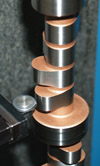Micro texturing camshaft surfaces
 A new concept from the French Surface preparation and coating specialist HEF promises to enhance performance at the cam/tappet interface by altering surface micro-topography. In high pressure applications the lubricant film separating two surfaces can be so thin it is little deeper than surface roughness, even where the components have been super-finished. “Clearly therefore micro-topography of surfaces can have a great influence on performance,” remarks HEF R&D specialist Louis Mourier. He says that HEF has been studying means to
A new concept from the French Surface preparation and coating specialist HEF promises to enhance performance at the cam/tappet interface by altering surface micro-topography. In high pressure applications the lubricant film separating two surfaces can be so thin it is little deeper than surface roughness, even where the components have been super-finished. “Clearly therefore micro-topography of surfaces can have a great influence on performance,” remarks HEF R&D specialist Louis Mourier. He says that HEF has been studying means to
alter that micro-topography for the past five years, initially focussing upon the cam/finger follower interface before investigating other potential applications. During that period the French engineering group successfully developed surface micro-texturing, which enhanced friction and wear characteristics.
The basic concept of micro-texturing is in effect to pit the surface in a carefully controlled manner. This is done by exploiting laser technology in such a way that surface flatness is not affected and there is no danger of creating stress raisers or cracks. The laser removes material from the surface, creating tiny dots or grooves, according to the specific requirement. Mourier says that, by way of example a dot might be 10 to 200 micron in diameter with a depth of up to 100 microns, but that this surface manipulation has no specific geometry – it is always application specific.
Mourier emphasis that the advantage that can be gained through surface micro-texturing is not due to enhanced oil retention, in the way that a piston ring working face might be micro-pitted to retain oil, for example. “Our surface micro-texturing causes a change in the way the oil flows – we manipulate the oil flow between two surfaces. This creates a lifting effect that actually parts the two components.”
Mourier remarks that if a cam is experimentally run against a tappet with increasing force, there will inevitably come a point at which the oil film breaks down. However, he says that the breakdown of the film can be delayed using the correct surface micro-texturing. “We can modify the characteristics of the lubricant film so that it withstands higher load”.
By the same token, Mourier says that HEF has obtained a measured reduction in friction through micro-texturing the working surface of a piston ring, with no change made to the cylinder bore surface. Mourier warns, however, that if not properly optimised for the specific application, surface micro-texturing can actually spoil rather than enhance performance. “Done correctly it will optimise the performance of a given contact area”.
HEF is currently concentrating on applying this technology to one of the two running companion surfaces but Mourier sees no reason why further gains should not be made from its application to both surfaces. While current applications have been successfully made at the cam/tappet and the ring/bore and the piston pin/con rod interface, other likely gains are to found at the piston skirt/bore and the crankshaft journal/bearing interface. Research work is continuing in many areas of the race engine.
Assisting this effort, Mourier added that the equipment has now been installed by HEF to apply very carefully controlled micro-texturing to a wide range of surfaces, coated and uncoated. The laser-based tool can apply specific micro-texturing to any surface that its beam can ‘see’.
Currently micro-texturing is being applied to uncoated steel parts but aluminium and other materials may follow. It is also being applied to PVD-applied coatings including titanium nitride, chromium-nitride and a range of Diamond Like Carbon (DLC) coating formulations. In the case of thin film advanced coatings, either the coated surface can be micro-textured or the substrate can be treated prior to coating, the optimum approach taken depends upon the component in question and the appropriate micro-texturing form.
Applied correctly, surface micro-texturing has been found to be more effective on a DLC coated than an untreated DLC surface. “Surface micro-texturing is complementary to DLC”, says Mourier. “Applied correctly, it is an advantage over untreated DLC”.
Written by Ian Bamsey.